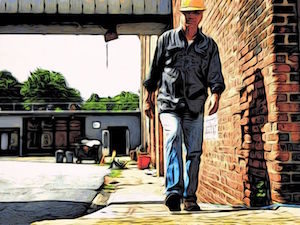Archive: Roads as History

My good friend Jeff Mann, the true Yard Ramp Guy, has asked me to revisit some of my original posts. This week in my From the Archives series: roads are literally, yes, a roadmap of history.

Paved with (Good?) Intentions
I write a lot about roads on this blog. The Yard Ramp Guy must think I'm a bit obsessed (though he’d probably phrase it differently).
The study of roads is the study of history. Countless historical events, from the outcomes of wars to international trade, and from religious expansion to the maintenance of nations: they all rely on roads.
Incan roads—not the most extensive network of ancient roads but one of the most technologically impressive—were earthquake-proof with incredibly durable suspension bridges. Roman roads have been receiving acclaim for millennia now, and many are still in use.
Which brings us to ancient Chinese roads.
Under the Qin Dynasty (circa 220 BC), Chinese road networks were considerably more extensive than their Roman contemporaries. One, the Ancient Road of Mules and Horses, was created in 214 BC by an advancing army of the Qin. The Emperor marched a half-million strong army in a straight line on one of his wars of conquest, crushing the earth in its path. They later covered the road in slate, and it remained in use for 2,000 years afterward without changing routes.

Walking up a golden ramp. Kind of.
Road maintenance was key in holding onto territory in China. Later dynasties, like the Han, went to great pains to maintain this and other roads, building hostels and post offices along their lengths. Another Qin road was immensely long, built to service border forts along a huge wall that predated the Great Wall.
My favorite ancient road of all, though, is the Stone Cattle Road. One of the ancestors of the First Qin Emperor wanted to conquer the nearby Shu kingdom to the south, over the Qinling Mountains. He had his sculptors and artisans carve five life-sized stone cows and decorate their tails and hindquarters with gold.
When the king of Shu received news of them, he asked the Qin king to send him a herd. The Qin king claimed that he would need a gallery road (built of wooden planks imbedded in the sides of cliffs) across the mountains to move the cows. The Shu king not only permitted it; he also helped fund the construction.
Yes, we know how this story develops: The first thing the Qin king brought over wasn't a herd of gold-depositing cattle. He brought an army.
Yard Ramp Guy Blog: Business Advantages
This week my friend The Yard Ramp Guy shows how buying his inventory can save you money.
Click HERE for his simple suggestions to make that happen.

Archives: Living Bridges

My good friend Jeff Mann, the true Yard Ramp Guy, has asked me to revisit some of my original posts. This week in my From the Archives series: if only our own infrastructure were as strong and natural as living bridges.
I've blogged a lot about bridges, I know (Sir Bridges Blog-a-Lot, eh?) but I haven't yet explored living bridges.
Meghalaya, a state in north-eastern India, is one of the wettest places in the world, getting close to 500 inches of rainfall a year. Almost three-quarters of the state is forested. One of the indigenous tribes living there, the War-Khasi, build living foot bridges from the roots of the Ficus elastica — a variety of rubber tree.
 Photo by Arshiya Urveeja Bose [CC BY 2.0], via Wikimedia Commons
Photo by Arshiya Urveeja Bose [CC BY 2.0], via Wikimedia Commons
To grow the bridges, the Khasis create root guidance systems out of halved and hollowed betel nut trunks. The roots are channeled to the other side of the river, where they are allowed to bury themselves in the soil on that side.
The bridges take 10 to 15 years to grow strong enough for regular use; once they do, they last incredible amounts of time with no maintenance: since they're still growing, they actually continue to grow stronger and stronger over time. Some of the older bridges are five centuries old. Many of the older, stronger bridges can support 50 or more people at once.

Sometimes I think about crossing a bridge.
The most famous of the bridges, the Umshiang Double-Decker Root Bridge, is actually two of those bridges, with one stacked directly over the other. Local dedication to the art has kept the bridges alive and prevented them from being replaced with steel. (Steel, frankly—and with all respect to those dealing with, ahem, yard ramps—doesn't have anything near the lifespan of the root bridges and aren't nearly as sturdy.)
The root bridges aren't the only living bridges around. In the Iya Valley in Japan, there are bridges woven out of living wisteria vines. They're much less common, and only three remain. They're built by growing immense lengths of wisteria on each side of the river before weaving them together—a process that must be repeated once every three years.
These wisteria bridges are much less sturdy than the Khasi root bridges, with wooden planks spaced over seven inches apart, and they apparently shake wildly while you're on them. By all accounts, these things are terrifying to cross, which makes sense: they’re widely thought to have been designed originally for defense. The original bridges didn't even have railings.
Yard Ramp Guy Blog: Industrial Protection
This week my friend The Yard Ramp Guy makes a compelling case for worker safety.
Click HERE to peruse his perspective on proper planning.

Archives: Playing with Pareidolia

My good friend Jeff Mann, the true Yard Ramp Guy, has asked me to revisit some of my original posts. This week in my From the Archives series: see something where nothing exists? It's okay: you're in good company.
Everyone plays the game as kids—the one where you look for objects in clouds, right? Even the least-imaginative kids could at least see sheep. Well, it turns out there's a name for it, and it's actually pretty important.

Whoa
It's called pareidolia. Broadly speaking, this is the brain's ability to perceive a familiar pattern in a stimulus where none actually exists. Other examples: mountainsides that resemble faces and trees that look like people.
People aren't the only entities that experience pareidolia. Computers do it, too. Google has a program called DeepDream that specifically sets out to exploit this, and it produces some really, really weird results. (DeepDream especially sees a lot of dogs.)
Pareidolia is fairly important in science, and it causes a lot of problems in archeology and paleontology. Amateurs are constantly picking up rocks they mistakenly think are arrowheads, dinosaur eggs, or bones. This happens so much that there's a specific name for rocks like this: mimetoliths. This also includes larger rocks, like the mountainsides that look like faces.

Yeah, well.
The most famous applied use of pareidolia is the Rorschach inkblot test, which is supposed to give insight into a person's mental state. A fairly successful tool, we’ve used the Rorschach continually since the early 20th century—fairly astonishing, since psychology has thrown away so much from that time period.
If you're familiar with the tabloid-fodder “Jesus appears on toast” articles, you've stumbled on another example of pareidolia. (And we know a woman who saves pieces of firewood because of, well, all those faces she sees in them. Apparently, they make for good company. We hope she has enough non-faced wood to keep warm this winter.)
It also sees extensive use in art, which is unsurprising. Many optical illusions (like the famous one that could either be a lamp or two faces) are good examples. Leonardo da Vinci wrote about pareidolia as a tool in art. Pareidolia is one of the main reasons cartoons work so well, making it easy for us to assign complex emotions to simple line drawings of people.
Pareidolia isn't good or bad—just reflects an aspect of how our brains interpret the world—but can also lead you astray. This phenomenon is also probably one of the coolest oddities involved in discovering how our brains work.
Yard Ramp Guy Blog: National Ramp Coverage
And speaking of pareidolia, this week my friend The Yard Ramp Guy is seeing umbrellas and The Munsters in his ramp maps.
Click HERE to experience the ramp world through his eyes.

Archives: Beta Testing WolframAlpha

My good friend Jeff Mann, the true Yard Ramp Guy, has asked me to revisit some of my original posts. This week in my From the Archives series: alternative search engines. WolframAlpha'ing, anyone?
Q: What is the average weight of a panda?
A: 170-290 lbs.

Searching for Engines
There are a lot of different search engines out there, but most people never feel the need to go past Google. For the most part, I'm with them. I have discovered a few specialty search engines that I visit on a regular basis. Most of these are simply engines that search inside a specific website, usually Wikipedia. There are a couple exceptions, though. The biggest one is called WolframAlpha.
Q: How many people have the given name McCoy?
A: 1649 estimated to still be alive in the United States.
Strictly speaking, WolframAlpha isn't a search engine at all. It's a computational knowledge engine. Its creator, Stephen Wolfram, designed the engine to answer factual questions by using its curated internal database of information. This is a very different function than search engines, which provide a list of documents or web pages that might contain the answer.
Q: Motorcycle traffic in Germany?
A: 11.1 billion vehicle miles per year.
WolframAlpha can perform arithmetic, trigonometry, algebra, and numerous other mathematical functions. It contains population estimates from around the globe. It records weather data from the past in the database. And so this computational knowledge engine can use all of this information, along with its countless volumes of other information, to calculate the answers to a huge number of questions.
Q: Melting point of teflon?
A: 327 degrees Celsius. (620.6 degrees Fahrenheit)
Not to say that Wolfram Alpha is perfect. Its databases don't contain anywhere close to even a significant percentage of human knowledge. It doesn't know the average speed of a turtle, for instance, so you couldn't use it to figure out how long it would take one to cross the United States.

My own computational knowledge engine.
A fun Twitter account I ran into the other day is dedicated entirely to sharing odd questions that Wolfram Alpha can't answer. My personal favorites:
- “Hectares of cotton crops needed to make a superhero cape for every land mammal.”
- “Total work done against gravity to make a cupcake rise while baking it, in calories?”
- “Most common English misspelling that changes the word's Scrabble score by more than 4?”
And knowledge crawls onward…
Q: Anchorage, Alaska weather on 7/7/07?
A: Overcast, 54 to 61 degrees Fahrenheit, wind 0 to 7 mph.
Q: Most frequently erupting volcano?
A: Stromboli, in Italy.
Q: 20 gallons of gloss paint?
A: 14,000 square feet, assuming it has a spreading capacity of 690 square feet per gallon.
Q: How long did the Paleoproterozoic Era last?
A: 900 million years.
Q: x+y=10, x-y=4
A: x=7, y=3
Q: What's the temperature of the solar wind?
A: 31,000 Kelvin.
Yard Ramp Guy Blog: Inventory Management
Any time someone calls out the emperor's new clothes, I'm all in. This week, my friend The Yard Ramp Guy does just that, and then shows us how his business has been more efficient than a backordered cleaning cloth.
Click HERE to wipe the slate...cleaner.






